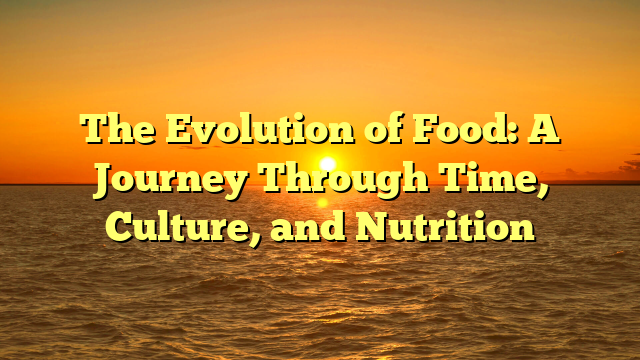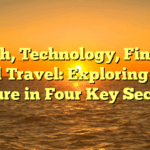Food is more than just sustenance—it is an integral part of our daily lives, our cultures, and
our identities. The journey of food is both rich and complex, spanning centuries, continents,
and civilizations. From ancient hunter-gatherer societies to the modern age of processed
foods, food has played a significant role in shaping human history, culture, and health. This
article explores the evolution of food, its cultural significance, and the nutritional value of the
foods we consume today.
The Beginnings: Hunter-Gatherers and Agricultural Revolution
The history of food starts with the earliest humans, who were hunter-gatherers. Early human
diets were shaped by what was available in the wild—fruits, nuts, seeds, roots, and wild
animals. These early humans were opportunistic eaters, relying on their environment for
sustenance and learning to adapt to different ecosystems. As they roamed the Earth, they
gradually began to understand the relationship between plants and animals, eventually
starting to domesticate both.
The Agricultural Revolution, which occurred around 10,000 years ago, marked a
monumental shift in food production. Humans transitioned from a nomadic lifestyle to settled
farming communities. This shift allowed people to cultivate crops and domesticate animals,
such as cows, sheep, and chickens. The cultivation of grains like wheat, rice, and corn
became staples of early societies. This period also led to the development of food
preservation techniques, such as drying, salting, and fermenting, which helped sustain
populations during off-seasons.
Ancient Civilizations: The Birth of Culinary Traditions
As societies grew more complex, food became a symbol of status and power. In ancient
civilizations, such as Egypt, Greece, and Rome, food was not only about nutrition but also
about culture and tradition. The ancient Egyptians, for example, developed a wide array of
bread, beer, and fermented foods, many of which were important parts of religious
ceremonies.
In ancient Greece, food and dining were integral to social and political life. The Greek
symposium, a gathering of intellectuals and elites, was a space for conversation, philosophy,
and indulgence in fine food and drink. The Greeks popularized olive oil, wine, and a diet rich
in fruits, vegetables, and grains—many of which are still central to Mediterranean cuisine
today.
The Roman Empire further developed the concept of food as a reflection of wealth and
social class. Roman banquets were lavish affairs, where exotic ingredients and elaborate
dishes were served. Fish, exotic fruits, and spices were prized, and the Romans began to
establish trade routes that allowed them to bring ingredients from far-flung corners of the
empire. This trade facilitated the exchange of not just goods, but culinary techniques and
recipes that have influenced world cuisine to this day.
The Middle Ages: Spices, Preservation, and Exploration
During the Middle Ages, the expansion of trade routes continued, bringing new ingredients to
Europe. Spices like pepper, cinnamon, and nutmeg became valuable commodities, traded
along the Silk Road from Asia to Europe. These spices not only enhanced the flavor of food
but also had medicinal properties, which made them highly sought after.
The Middle Ages also saw the growth of food preservation methods. With refrigeration not
yet available, preserving food through salting, pickling, and smoking became common
practice. These techniques allowed food to be stored for long periods, especially in colder
months, ensuring that communities could survive through harsh winters.
The discovery of the New World in the late 15th century changed the landscape of food even
further. New ingredients, such as tomatoes, potatoes, maize (corn), chocolate, and chili
peppers, were introduced to Europe. These ingredients would go on to revolutionize
European and global cuisines, forming the foundation of dishes and flavors we recognize
today.
The Industrial Revolution: The Rise of Processed Foods
The Industrial Revolution in the 18th and 19th centuries had a profound impact on the way
food was produced, distributed, and consumed. Advances in technology allowed for mass
production of food on an unprecedented scale. The rise of factory farming and mechanized
food production led to cheaper, more accessible food for the growing urban population.
Canned foods, preserved meats, and ready-to-eat meals became more common, allowing
people to consume food with less preparation. As cities grew and people moved away from
rural areas, convenience became a priority. The development of refrigeration allowed
perishable goods to be transported over long distances, leading to the globalization of food
production.
However, the rapid rise of processed foods also brought new challenges. While these foods
were convenient and affordable, many were also high in unhealthy fats, sugars, and sodium.
This marked the beginning of the modern-day health challenges we face today, such as
obesity, heart disease, and diabetes, all of which are linked to poor dietary habits.
Modern Food: Globalization, Innovation, and Sustainability
In the 20th and 21st centuries, food has become more globalized than ever. Global trade has
made it possible to enjoy a diverse array of foods from all over the world. Italian pasta,
Japanese sushi, Mexican tacos, and Indian curries are now enjoyed by people of all cultures
and backgrounds, thanks to the interconnectedness of the world.
The rise of fast food chains in the mid-20th century also changed the way people
approached food. With the advent of fast food, eating became quicker and more efficient, but
often at the cost of nutritional value. Fast food, convenience foods, and sugary snacks have
contributed to the rise of diet-related diseases in many parts of the world.
In recent years, however, there has been a growing focus on healthy eating, sustainable
farming, and food innovation. Many people are now turning to organic, locally sourced
ingredients, and plant-based diets in an effort to reduce their environmental impact and
improve their health. The rise of food technology has also led to innovations like lab-grown
meat, alternative protein sources, and the development of more sustainable packaging.
Conclusion: The Future of Food
The evolution of food is a testament to human ingenuity, culture, and adaptability. From the
simple hunter-gatherer diets of early humans to the fast-food nation we live in today, food
has played an integral role in shaping our world. As we move forward, it is clear that food will
continue to evolve, with sustainability, nutrition, and technological innovation taking center
stage.
powerlensnews.5g.in of food may be defined by a deeper connection to the land, a focus on health and
well-being, and a commitment to reducing our impact on the environment. Whether it is
through embracing new food technologies or returning to ancient culinary traditions, the
journey of food will continue to shape the way we live, eat, and interact with the world around
us.
The Evolution of Food: A Journey Through Time, Culture, and Nutrition










